Planting onions to save your greens and cabbage


For years we grew cabbage and other greens in our garden, but we always ended up with the same result. All of our cabbage and greens would be riddled with worm holes. It was always so disappointing to remove the outer leaves of a cabbage to find it full of holes, or pick a bunch of spinach, lettuce, or kale that looked like Swiss cheese. We set out to find an answer that didn’t include pesticides. After a lot of research we were no closer to an answer. Finally one day after reading about homesteaders from the 1800’s, we found the answer was onions. As it turns out many of the bugs that like greens, don’t like onions. We decided to try it, what did we have to lose? We planted onion sets in between our greens. It was also fortuitous that both greens and onions needed to be planted in cool weather.
In the above picture you can see how we planted in this case along side kale. After a month it became apparent, that the old timers really knew what they were doing. It’s hard to imagine how much of their knowledge has been lost, but we are happy to have been able to preserve this small piece of knowledge, and pass it down to our children who we hope will always plant onions with their greens. The onions didn’t totally eliminate the problem, but they were 90% effective, and we are willing to give up the 10% to keep pesticides out of our garden. This approach is not only better for us but also for our bees. It is hard to argue with the results.
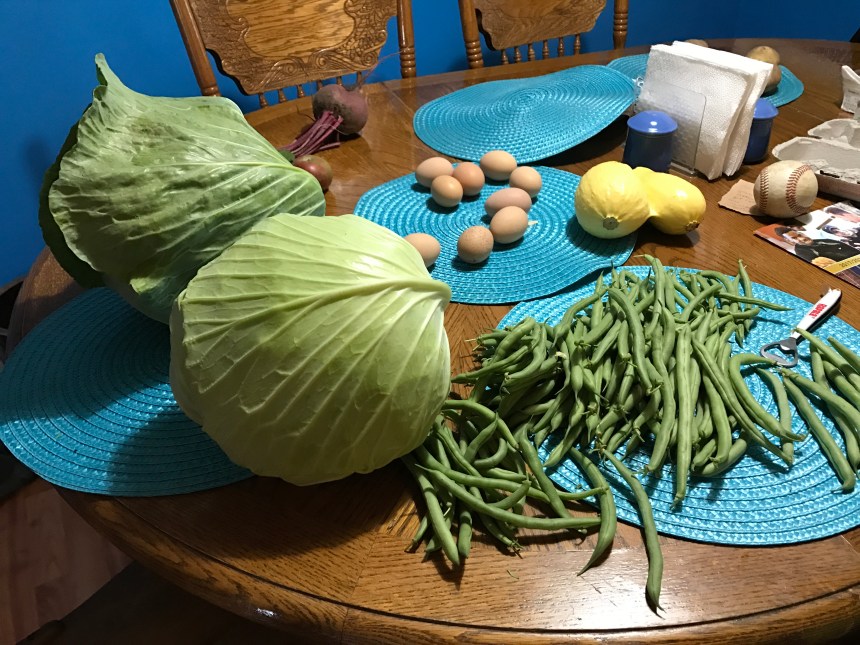
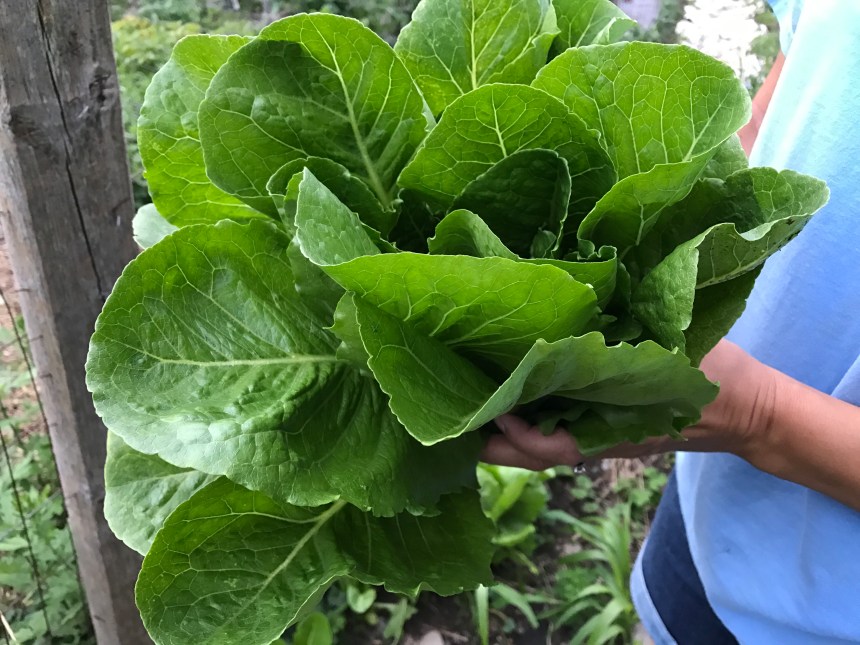
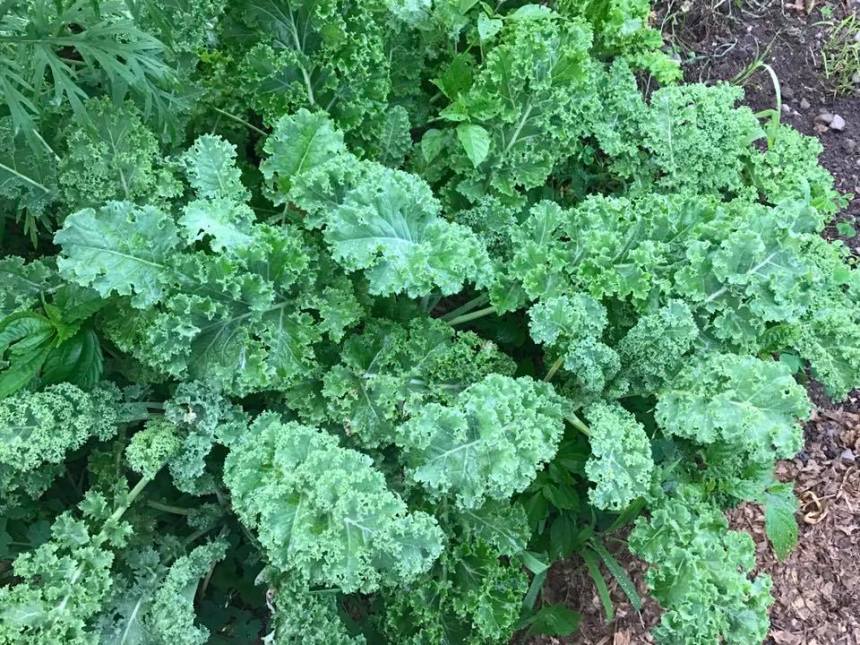
We were so happy to have these amazing vegetables, and feel safe giving them to our family knowing that they are pesticide free.
Harvesting onions
After harvesting the greens there is an added bonus, beautiful onions. Onions are harvested in mid summer normally in our area. We wait for the onions to tell us when they are ready to be harvested. When onions are finished growing for the year, their tops will fall over.
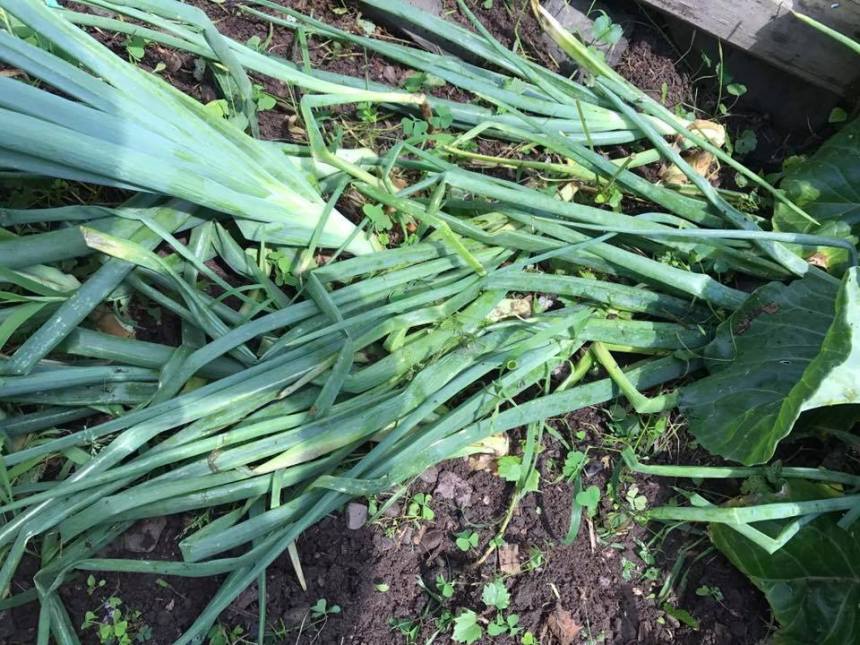
After this happens we pull the onions and lay them out in the sun to cure. Curing onions properly allows us to have onions well into the winter. Different varieties keep better than others. In our experience yellow onions keep better than white or red.
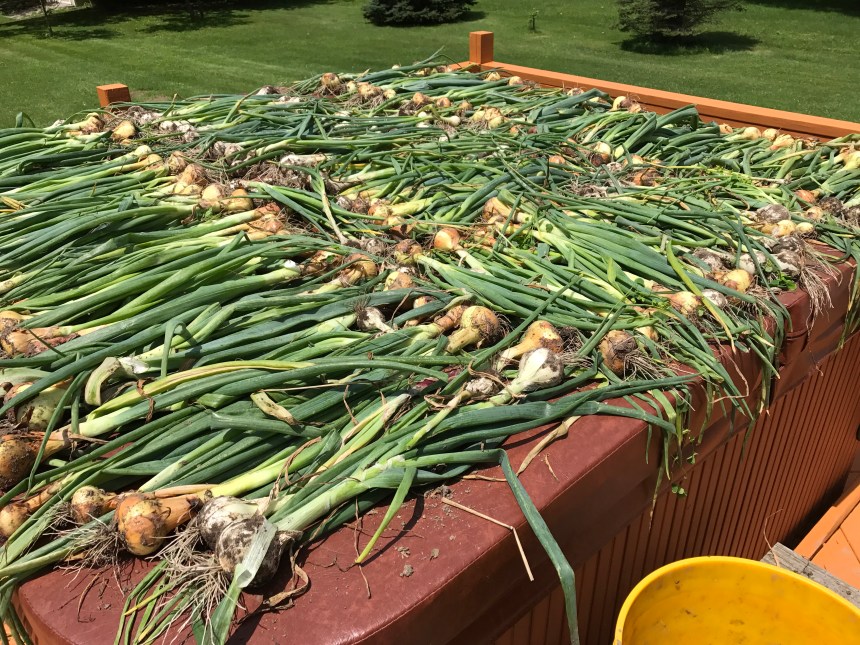
After the dirt on the onions dries, and the tops wilt, we move them to a covered location to continue drying. We put them onto wire mesh to allow air to circulate around the whole onion. This keeps them from growing mold and rotting.

Once the onions have dried, and their skins are like paper, they can be stored in an onion bag. We like to hang ours to encourage air circulation. Any onions with and bruises or blemishes should not be stored, we take these onions and dice them. Once they are diced they can be frozen. Cutting up 30 or 40 onions can make you cry, so try swim goggles while dicing. The diced onions are great when you are pressed for time when cooking.
Growing food like anything else in life it takes time and experience to learn. Because of this we always seek the advice of people who have done it before. In this case we would be remiss if we didn’t thank those tough old homesteaders who plowed the ground before us and showed us the way. Sometimes in life and gardening you need to take a step back to move forward. In an age of quick fixes and a chemical for every problem, all we really needed to do was look back to how our forefathers did things to find a solution. 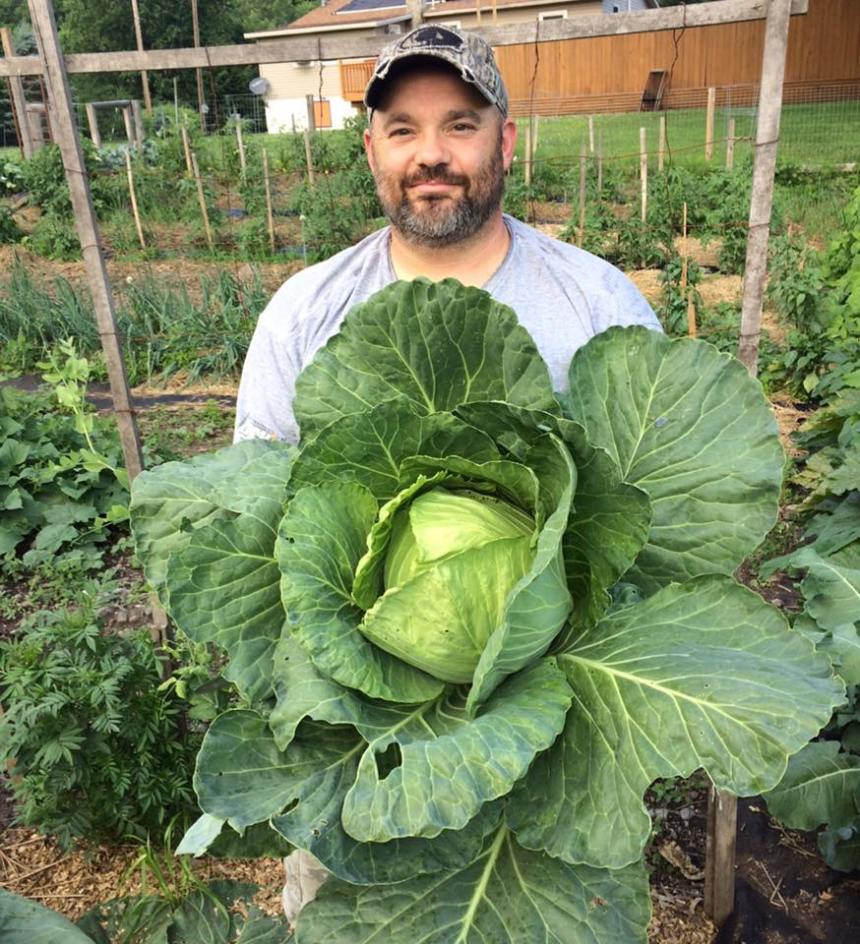




Awesome!!!!!!!!!!!! thanks
LikeLiked by 1 person
Anytime boss
LikeLike
We fought worms off our greens for months last year! So frustrating. Thanks for the tip! I’ll definitely be trying it this Spring.
LikeLike
It seems to work well for us I am not sure about slugs we make beer traps for them good luck let me know if it works for you too
LikeLiked by 1 person
I’ve read that pennies on the boarder (works great for raised beds) can keep slugs and some other crawlers at bay. 🙂
LikeLike
Oh cool thanks for the tip I may try that
LikeLike
Great article….I will try interspersing onions with those crops …I have also had good luck with floating row cover.
LikeLike
Great idea I’ve never used them but I see a lot of people who do I need to try it this year
LikeLike
I live in South Australia, and over the past 3 years have found that planting onion and garlic in each bed definitely protects the other veggies. I plant them in my strawberry patch, cabbage, cauliflower and broccoli, and sprouting broccoli, As well as lovely fresh healthy veggies, I get lots of lovely onions and garlic. This year I will be also interspersing Leeks. I dont think they will be as effective especially if it was by themselves, but as an addition to garlic and onions – I hope it will be a useful addition. Good luck everyone – isn’t gardening so exciting!!!!
LikeLiked by 1 person
That is awesome I may try them with some other crops a s well thank you so much for the tip and have a great weekend
LikeLike
Appreciate the info… giving it a try!!!
Do have any hints on those pesky squash bugs ???
LikeLiked by 1 person
I’ve tried d e but that’s about it if I get them early it’s good if not they usually win
LikeLike
I planted marigolds with my tomatoes, cucumbers, and squash and didn’t have any bug issues this summer. They were close enough to the green beans to help some there as well. Had onions near my brussel sprouts but still had issues. Wonder if marigolds would help that too?
LikeLike
I also plant marigolds they are really helpful mine came up pretty late this year but they still helped I think 🤔 the onions really work with my cabbage lettuce and spinach the woodchuck ate my Brussel sprouts 😳
LikeLike
Helpful info, please at what age of the greens should the onions, galic, marigold etc be planted? Thanks
LikeLike
I plant onion sets at the same time I plant the greens they are very cold hearty
LikeLike
Wow!! What a great hack? I never knew onions can help in controlling bugs that destroy my vegetables. I will definitely try this on my backyard garden. Thank you for sharing.
LikeLike
It really worked well for me before I did this my cabbage was useless marigolds also helped
LikeLike
Pingback: Planting onions to save your greens and cabbage – two branches homestead | SOMEONE SOMEWHERE
I’m definitely going to try this when I get planting in a few weeks.
LikeLiked by 1 person
It has worked well for us we also plant marigolds around the garden
LikeLike
I’ll try that too. I have lots of flowers around my garden but I’m going to try having a few in with the crops.
LikeLike
I’ve done it for the last few years and it seemed to help
LikeLike
so much excellent information on here, : D.
LikeLike
thank you
LikeLike
Thank you for sharing this pearl of info! I’m going to try this! I have worked and faught Soooo hard to stay completely organic gardening. I spend back breaking hours picking worms and I still always lose my cabbages to worms!!! Thank you again!
LikeLiked by 1 person
We are in zone 5b and have good luck with it I plant 100s of opinions around them
LikeLike
Reblogged this on two branches homestead.
LikeLike
I use onions and garlic with all greens. Really helps. Marigolds and nasturtiums help with tomatoes and peppers. I also plant radishes with cucumbers and squash. I harvest the radishes are they mature and just keep planting more. They grow so quickly I get a constant supply of radishes and bug protection too. Learned to do this from my grandfather many years ago.
LikeLiked by 1 person
I have planted marigolds before never tried radish with the cukes I’ll try it this year what do they keep away ? Thanks so much for the tip and for reading happy thanksgiving
LikeLike
I also plant onions to repel cabbage moths. Last year I tried Zinnia and marigolds to repel potato bugs, basil to repel just about every bug that hits on tomatoes, green beans and cucumbers. Nasturtium for aphids, they actually will attract all the aphids then I simply spray them with a dose of diluted peppermint castile soap. They all worked awesome! Look up companion planting.
LikeLiked by 1 person
That’s so awesome I plant a lot of those plants as well it’s not perfect but really helps and better than using pesticides
LikeLike